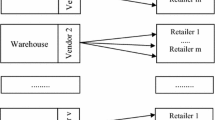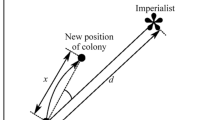Abstract
Vendor-managed inventory (VMI) system is a mechanism where the supplier creates the purchase orders based on the demand information exchanged by the retailer/customer. In this paper, the performance of the traditional and VMI system is compared. Mathematical modeling is applied and total inventory cost in the supply chain is used as the performance measure. The supply chain is considered in two levels, i.e., buyer and supplier, with the assumption that the supplier faces only one buyer as the contract party. Since none of the previous works quantitatively directed the practitioners to select the traditional or VMI system, the extent point is introduced in which the difference in total cost of both systems is minimal. It is applied to investigate how increasing or reducing the related parameters changes total cost of two systems with respect to each other. A numerical example and sensitivity analysis are provided to illustrate the theory and derive the extent points and percentage of difference in total cost of the traditional and VMI system. The results show that VMI works better and delivers lower cost in all conditions including back order, and as one goes farther from the extent point, the application of VMI is more justified.
Similar content being viewed by others
References
Sharma S (2009) A composite model in the context of a production-inventory system. Optimization Letters 3:239–251
Magee JF (1958) Production planning and inventory control. McGraw-Hill Book Company, New York, pp 80–83
Waller M, Johnson ME, Davis T (1999) Vendor-managed inventory in the retail supply chain. J Bus Logist 20:183–203
Sharma S, Sadiwala CM (1997) Effects of the lost sales on composite lot sizing. Comput Ind Eng 32:671–677
James R, Rich N, Francis M (1997) Vendor-managed inventory: a processual approach, Proceedings of the 6th International IPSERA Conference, Ischia, Italy, 24–26 March 1997
James R, Francis M, Rich N (2000) Vendor-managed inventory (VMI): a systemic approach. In: value stream management, strategy and excellence in the supply chain. Financial Times/Prentice Hall, Harlow, pp 335–357
Fox ML (1996) Integrating vendor-managed inventory into supply chain decision-making, APICS 39th International Conference Proceedings, New Orleans, pp 126–128
Simchi-Livi D, Kaminsky P, Simchi-Livi E (2000) Designing and managing the supply chain: concepts, strategies, and case studies. McGraw-Hill, Singapore
Holmstrom J (1998) Business process innovation in the supply chain: a case study of implementing vendor-managed inventory. Eur J Purch Supply Manag 4:127–131
Cachon G, Fisher M (1997) Campbell soups continuous replenishment program: evaluation and enhanced inventory decision rules. Prod Oper Manag 6:266–276
Cheung KL, Lee HL (2002) The inventory benefit of shipment coordination and stock rebalancing in a supply chain. Manag Sci 48:300–306
Gavirneni S (2001) Benefits of co-operation in a production distribution environment. Eur J Oper Res 130:612–622
Lee HL, Padmanabhan V, Whang S (1997) The bullwhip effect in supply chains. Sloan Manage Rev 38:93–102
Chen F, Drezner Z, Ryan JK, Simchi-Levi D (2000) Quantifying the bullwhip effect in a simple supply chain: the impact of forecasting, lead times and information. Manag Sci 46:436–443
Disney SM, Towill DR (2003) Vendor-managed inventory and bullwhip reduction in a two-level supply chain. Int J Oper Prod Manage 23:625–651
Disney SM, Towill DR (2003) The effect of vendor-managed inventory (VMI) dynamics on the bullwhip effect in supply chain. Int J Production Economics 85:199–215
Xu K, Dong Y, Evers PT (2001) Towards better coordination of the supply chain. Transp Res Part E: Logist Trans Rev 37:35–54
Aviv Y, Federgruen A (1998) The operational benefits of information sharing and vendor-managed inventory (VMI) programs. Working paper. Washington University, St. Louis
Tyan J, Wee HM (2003) Vendor managed inventory (VMI): a survey of the Taiwanese grocery industry. Eur J Purch Supply Manag 9:11–18
Cachon GP, Fisher M (2000) Supply chain inventory management and the value of shared Information. Manag Sci 46:1032–1048
Disney SM, Potter AT, Gardner BM (2003) The impact of vendor-managed inventory on transport operations. Transp Res 39:363–380
Tersine RJ, Barman S, Morris JS (1992) A composite EOQ model for situational decomposition. Comput Ind Eng 22:283–295
Jong JF, Wee HM, Chung CJ (2008) A near optimal solution for integrated production inventory supplier-buyer deteriorating model considering JIT delivery batch. Int J Comput Integr Manuf 21:289–300
Wee HM, Yang PC (2007) A mutual beneficial pricing strategy of an integrated vendor-buyers inventory system. Int J Adv Manuf Technol 34:179–187
Yang PC, Wee HM, Hsu PH (2008) Collaborative vendor-buyer inventory system with declining market. Comput Ind Eng 54:128–139
Lee H, So K, Tang C (2000) The value of information sharing in a two-level supply chain. Manag Sci 46:626–643
Sterman J (1989) Modeling managerial behavior: misperceptions of feedback in a dynamic decision making experiment. Manag Sci 35:321–339
Yao Y, Evers PT, Dresner ME (2007) Supply chain integration in vendor-managed inventory. Decis Support Syst 43:663–674
Author information
Authors and Affiliations
Corresponding author
Rights and permissions
About this article
Cite this article
Razmi, J., Hosseini Rad, R. & Sangari, M.S. Developing a two-echelon mathematical model for a vendor-managed inventory (VMI) system. Int J Adv Manuf Technol 48, 773–783 (2010). https://doi.org/10.1007/s00170-009-2301-7
Received:
Accepted:
Published:
Issue Date:
DOI: https://doi.org/10.1007/s00170-009-2301-7




